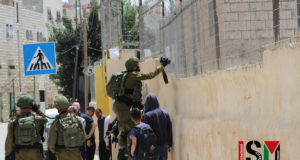Gaza / Occupied West Bank 12/24/2023 Hundreds of thousands of Palestinian children in Gaza are at risk of famine and preventable death from disease as the world’s observant retreat into family and faith to mark the birth of ...
Read More »Worldwide Pressure Escalates with Global Strike for Gaza
Striking Palestinians across the occupied West Bank have been joined by millions in countries across the world for the Global Strike for Gaza, which was announced by a coalition of major Palestinian factions. The cadence of the strike ...
Read More »Masafer Yatta Families Displaced Following Home Demolitions
7 December 2023 | International Solidarity Movement | Masafer Yatta, Occupied West Bank In just over one week, several Palestinian family homes were relegated to fields of rubble after occupation army bulldozers invaded several villages including al Deirat, Umm Lasafa ...
Read More »UPDATE on Gaza Workers: 900 arrested by Occupation forces in West Bank
We have heard that 900 of the Gazans working in Israel have been arrested over the past two days. Amongst those detained are 30 of the 45 men we saw in Hebron. They were arrested by the Occupation forces on ...
Read More »Attacks and disruption in Al-Khalil as settlers celebrate Sarah’s Day
December 29 | International Solidarity Movement | Al-Khalil Around 30,000 settlers gathered in Al- Khalil (Hebron) on Saturday, November 19, to celebrate Sarah’s Sabbath and wreaked havoc in the Old City market, attacking Palestinians and their shops, houses and destroying ...
Read More »About the legitimisation of the Palestinian oppression in Al Khalil (Hebron)
Personal reflections of a ISM activist about the settlers' violence and its related impunity in Al Khalil, West Bank. To which extent these people are allowed by the Israeli soldiers to transform a Palestinian city into their own amusement-park?
Read More »When holidays bring hate: Sarah’s Day in Occupied Hebron
For Palestinians living in Occupied Hebron, Sarah's Day, a major Jewish holiday, means an increase in violent attacks by illegal Israeli settlers.
Read More »Waiting at a checkpoint
An ISM activist writes about her experiences volunteering in Hebron (Al Khalil) during Netanyahu's visit to the city.
Read More »Telling old stories in a new way: Palestinian dabke
At the first annual Hebron Festival, an event organized by the Hebron Municipality to celebrate the culture and history of Palestinians in Hebron, students from across the West Bank put on a theatrical performance, telling of life and history in Palestine through a play combined with music and dabke.
Read More »Education under occupation
August 11 | International Solidarity Movement | Hebron, occupied Palestine Whilst continuing my work with ISM this year, I spent four weeks working at the Hebron/al-Khalil office of Defence for Children International focussing on the way that the occupation has ...
Read More » International Solidarity Movement Nonviolence. Justice. Freedom.
International Solidarity Movement Nonviolence. Justice. Freedom.









